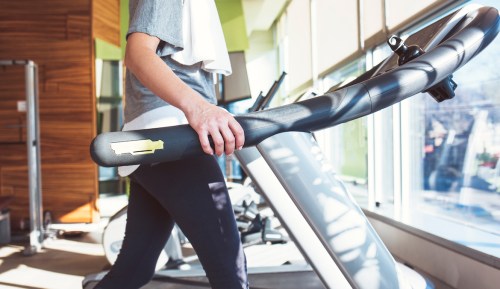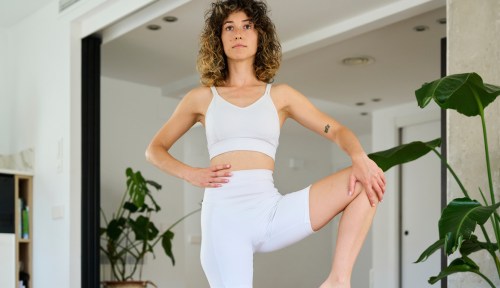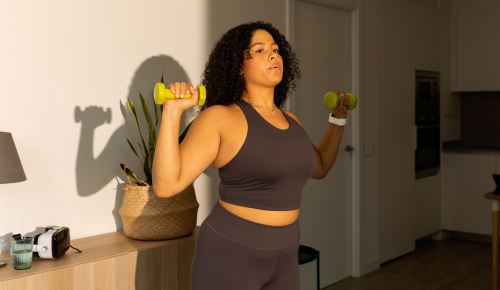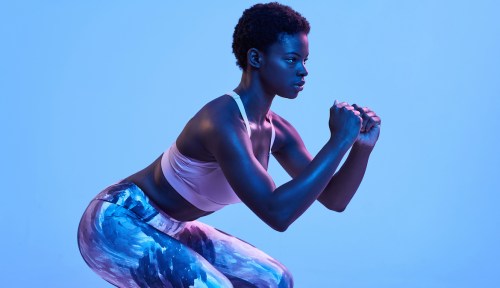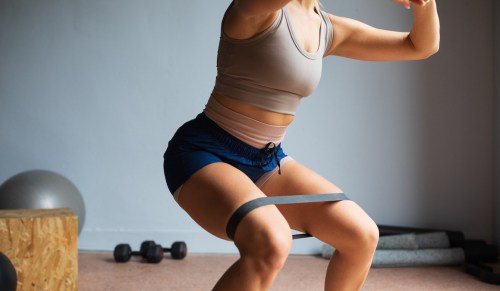Strength training has been one of Ashley Graham’s fitness and health priorities for years. But now that the model, advocate, entrepreneur, and author is also the mom of a 4-year-old and 2-year-old twins, that strength, in practice, looks a little different.
“I can hold all three kids at the same time: One on the back and two in the front,” Graham says. “The one on the back is really suffocating me, [but] I can still run down the hall, down the steps, and get to the kitchen, without somebody dropping. That’s a relay race in itself.”
Along with her feats of strength, her mindset about fitness and the way she chooses to exercise have changed, too. Part of that is about honoring what she really wants and needs with the limited time she has to move her body just for her, and part of it is about changing priorities.
“Before kids, I was like, let’s go to the gym four days, maybe five days a week, it was all about just really focusing on building muscle, staying strong, being as healthy as possible,” Graham says. “But now being a mom of three, building businesses, and having a multitude of things on my plate at all times, for me, the gym needs to be a haven.”
From pounding the battle ropes to battling it out on the play mat, here’s how Graham has changed her approach to fitness since becoming a mom.
1. She tunes into the needs of her body
Graham shows up to the gym with two things in mind: her long-term wants, and her short-term needs. Sometimes that looks like is pushing her athletic limits, and sometimes it’s focusing on restoration and recovery.
“[The gym is a] space where I can come and say, okay, you know what? Today I want to feel strong, let’s lift weights,” Graham says. “But today, this morning I saw my trainer and I said, there’s something weird going on with my knee. I don’t know what’s going on, but it feels like it’s been pulled. And so we just foam rolled and massaged it and we did some band work because that’s what I needed.”
2. She embraces (mental) flexibility
Being able to tune into those needs means not always being so tied to what’s on the workout plan or agenda for that day. That can be challenging with strength training, because a plan of progressive overload is the most tried and true way to build muscle—and that had been the way she approached fitness before kids. But now, she fits in fitness where she can, in the way that feels best for that day or week.
“There are weeks where I try to knock it out before everybody wakes up at six o’clock,” Graham says. “But then there are some times where I just try to do it in the afternoon, like an early evening workout and everybody’s in the gym together.”
3. She focuses on fun
Involving her family often means thinking less about traditional “fitness” and more about movement and play. When Graham’s kids are in the gym with her, they’ll play with a blow up ball, or lift their own 2-pound weights while Graham is lifting heavier. “It’s just fun,” Graham says.
Play isn’t just limited to kid time, though. Graham and her trainer have been bringing out the fun in movement by tapping into Graham’s competitive spirit.
Recently, Graham and her trainer took inspiration from the Olympics and used Meta AI to craft a summer games-esque fitness relay race. In the Instagram video Graham posted below, you can see how the generative AI chat tool came up with activities and rules that put Graham and her trainer head to head.
4. Creativity is key
Graham and her trainer like to think outside the box (or the gym). For the relay race, they didn’t just focus on weights and other gym equipment. They told the Meta AI tool what resources they had available to them (like the pool), and made movement and a game out of things and places around the house.
“It was literally using the things that were in my backyard that my kids play with,” Graham says. “It was so fun. Because I won.”
Being creative in your workout session has health benefits1, too. Mixing things might actually help you stay motivated to get moving more often, and even make workouts more effective. Variety, novelty, and fun can help you avoid a workout rut.
5. Strength is for longevity
While the movement Graham does is fun in the moment, it’s also in service of the future. Building and maintaining muscle is one of the best preventative health measures a person can take for healthy aging. That’s very much on Graham’s mind as she pumps out reps.
“I have seen so many people in their 70s that have had so much just atrophy within their body,” Graham says. “I’m still in my mid-30s, but it’s something that I’m cognizant of because I want to be as healthy as possible for as long as possible.”
Lakicevic, Nemanja et al. “Make Fitness Fun: Could Novelty Be the Key Determinant for Physical Activity Adherence?.” Frontiers in psychology vol. 11 577522. 15 Oct. 2020, doi:10.3389/fpsyg.2020.577522
↩︎
Sign Up for Our Daily Newsletter
Get all the latest in wellness, trends, food, fitness, beauty, and more delivered right to your inbox.
Got it, you've been added to our email list.

